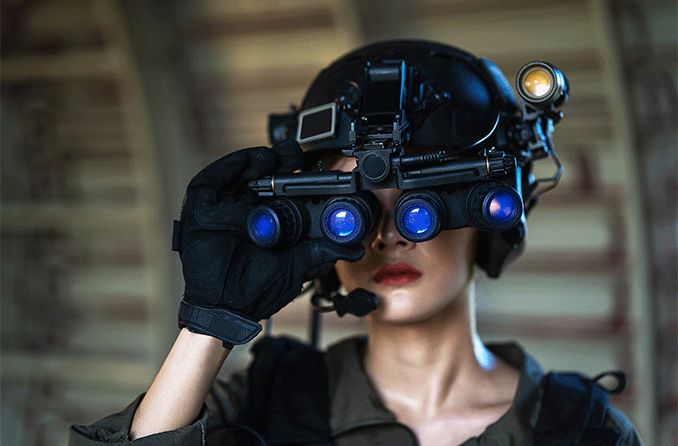Types of night vision devices
There are different types of night vision devices available on the market today. Some of these devices are designed for specific purposes, while others can be used for a variety of applications. Here is a look at some of the most popular types of night vision devices:
- Binoculars: Binoculars are perhaps the most common type of night vision device. They typically consist of two eyepieces and an objective lens, which helps to magnify the image. Binoculars can be handheld or mounted on a tripod, making them ideal for long-range viewing.
- Goggles: Goggles are another popular type of night vision device. Unlike binoculars, goggles only have one eyepiece, which can make them more comfortable to wear for extended periods of time. Goggles are also typically lighter and more compact than binoculars, making them easier to carry.
- Cameras: Cameras are another popular type of night vision device. With a camera, you can take pictures or video in low-light conditions. Many cameras come equipped with infrared technology, which allows you to see in complete darkness.
- Scopes: Scopes are another popular type of night vision device. Scopes use an objective lens and an eyepiece to magnify the image, making them ideal for long-range viewing. Scopes can be handheld or mounted on a tripod, making them easy to use in a variety of situations.
How they work
Night vision devices work by amplifying the available light, whether it be natural or artificial. The most common type of night vision device is an image intensifier, which takes the available light and amplifies it electronically. This type of device typically consists of a photocathode tube and a phosphor screen.
The photocathode tube is located at the front of the device and is used to convert photons into electrons. The electrons are then accelerated through a series of grids and hit the phosphor screen, which converts them back into photons. This process amplifies the available light, making it possible to see in low-light conditions.
Infrared technology is another common type of night vision. This type of technology uses an infrared sensor to detect infrared radiation, which is invisible to the naked eye. The sensor converts the infrared radiation into an electrical signal, which is then amplified and displayed on a screen.
Thermal imaging is another type of night vision technology that can be used to see in low-light conditions. This type of technology detects the heat signature of an object, rather than the light emitted by it. Thermal imaging can be used to see through smoke, fog, and other obscurants.
Advantages and disadvantages of each type
Each type of night vision device has its own advantages and disadvantages.
Binoculars are perhaps the most common type of night vision device. They typically consist of two eyepieces and an objective lens, which helps to magnify the image. Binoculars can be handheld or mounted on a tripod, making them ideal for long-range viewing.
Advantages:
– Can be used for long-range viewing
– Can be handheld or mounted on a tripod
Disadvantages:
– Can be bulky and difficult to carry
– Can be expensive
Goggles are another popular type of night vision device. Unlike binoculars, goggles only have one eyepiece, which can make them more comfortable to wear for extended periods of time. Goggles are also typically lighter and more compact than binoculars, making them easier to carry.
Advantages:
– More comfortable to wear for extended periods of time
– Lighter and more compact than binoculars
Disadvantages:
– Can be difficult to see in peripheral vision
– Can be expensive
Cameras are another popular type of night vision device. With a camera, you can take pictures or video in low-light conditions. Many cameras come equipped with infrared technology, which allows you to see in complete darkness.
Advantages:
– Can take pictures or video in low-light conditions
– Some models come equipped with infrared technology
Disadvantages:
– Can be expensive
– Some models require a separate infrared illuminator
Scopes are another popular type of night vision device. Scopes use an objective lens and an eyepiece to magnify the image, making them ideal for long-range viewing. Scopes can be handheld or mounted on a tripod, making them easy to use in a variety of situations.
Advantages:
– Ideal for long-range viewing
– Can be handheld or mounted on a tripod
Disadvantages:
– Can be expensive
– Some models require a separate infrared illuminator
